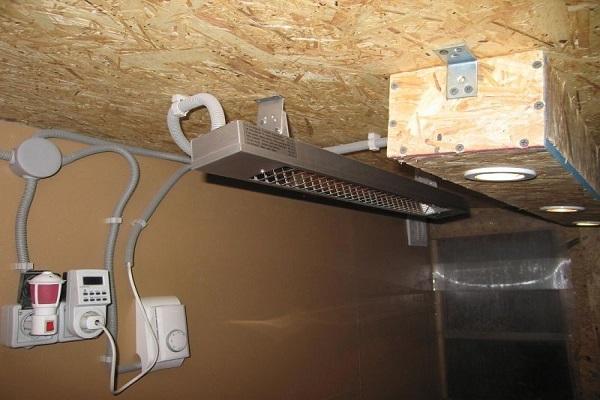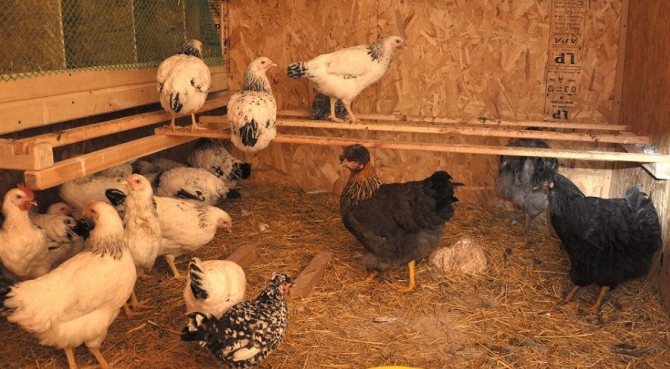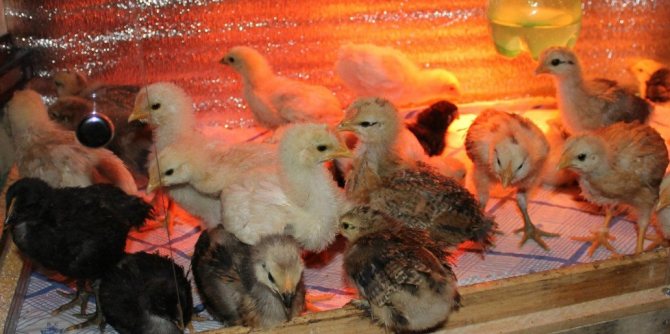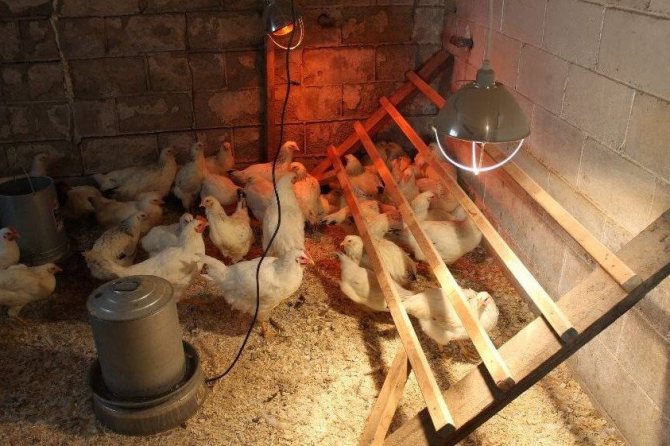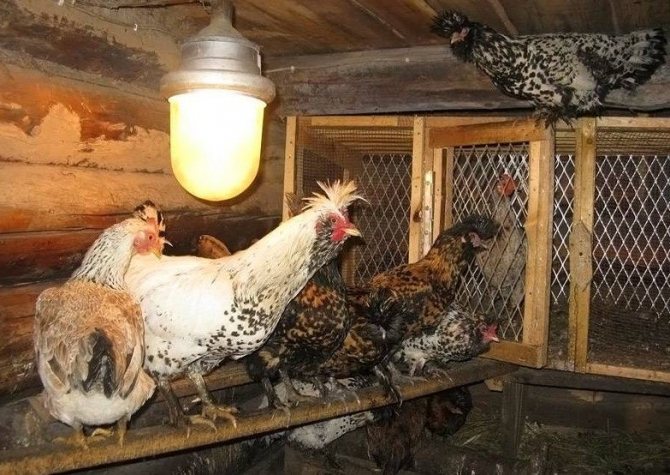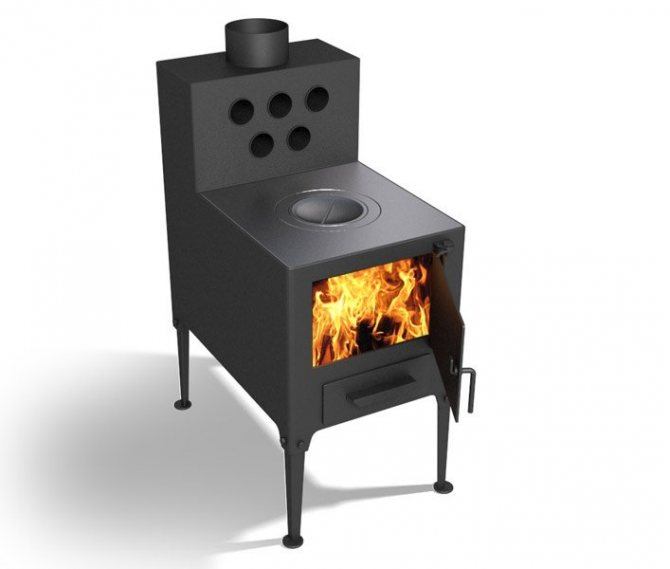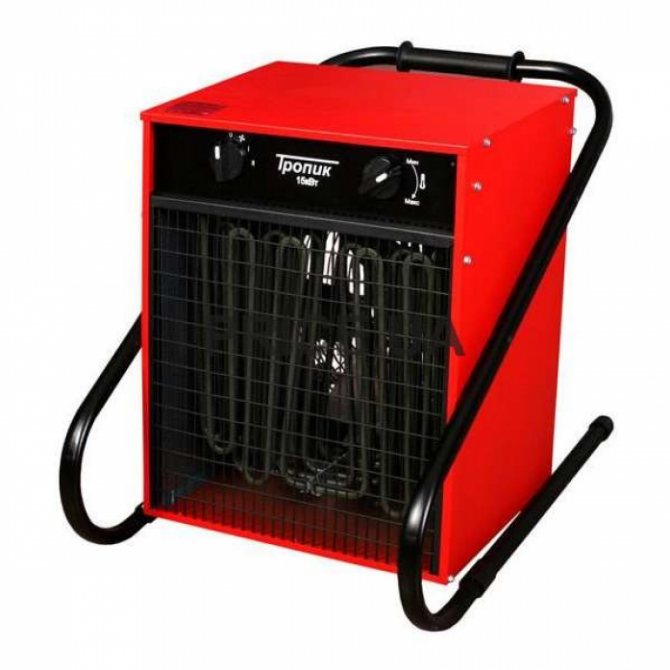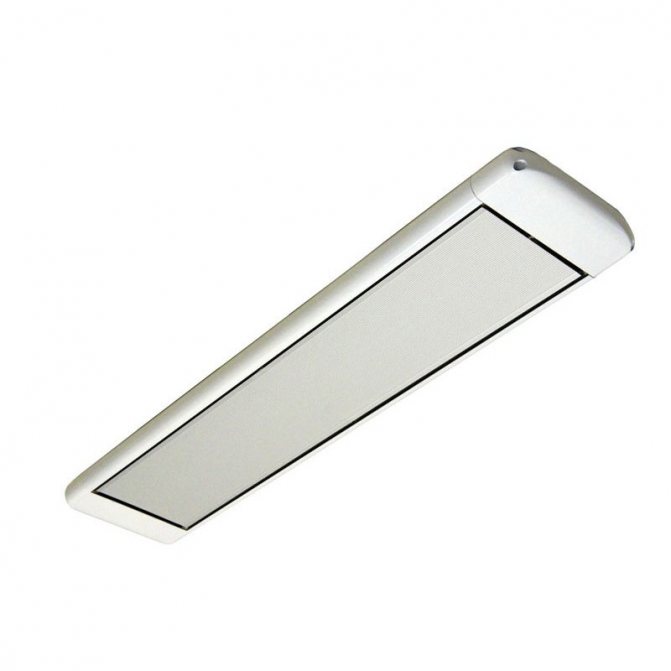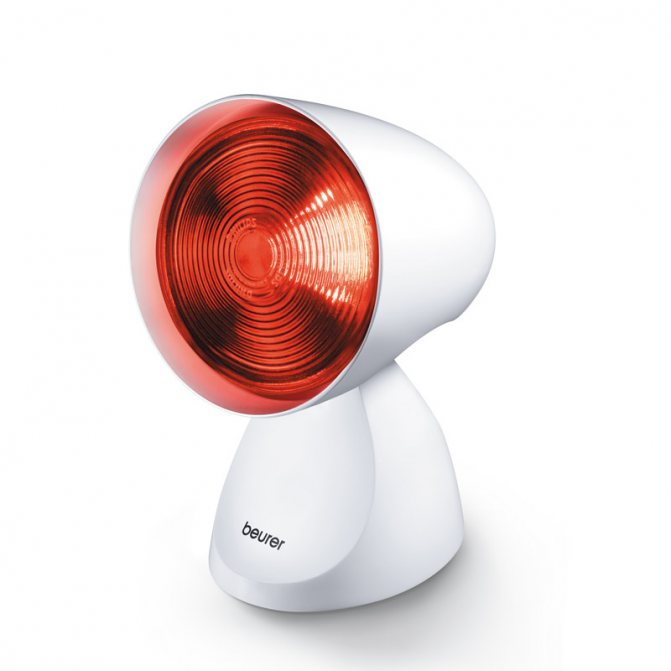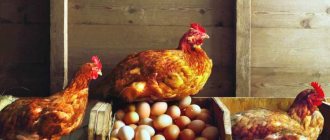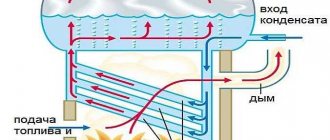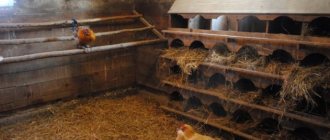222
no comments yet
0
The author of the article
Ryzhakova Evgeniya
Reading time: 7 minutes
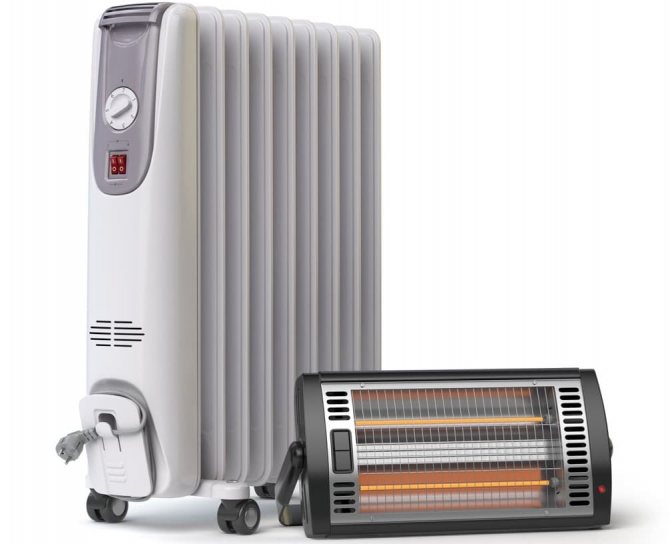
In winter, the chicken coop needs heating. Without it, many breeds stop rushing, and some may even get sick and die. And one of the ways to heat chickens in winter is with infrared lamps. Let's figure out what they are, how they are installed and which ones are better to choose for use.
Winter maintenance
In winter, chickens rarely leave the hen house. In an insufficiently warm room, they often get sick, egg production and weight gain decrease. Before purchasing a chicken heater, it is determined how warm the chicken coop should be. Today there are frost-resistant breeds. If the walls and floor of the barn are insulated, then some hybrids can easily tolerate cold even without installing a heater.
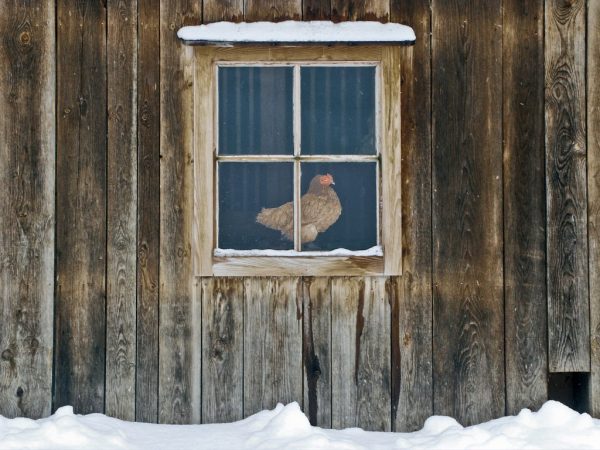

Correct and competent keeping of chickens in the winter season guarantees the preservation of egg production in layers and the general comfort of their life at low temperatures
The climatic conditions of the region are also taken into account. If the winter is warm, then a powerful heater for a captive chicken coop is not needed. In regions with cold winters, the issue of heating the house is taken more seriously.
Regardless of the climatic conditions of the region, the building is sheathed with thermal insulation, thanks to which it is cool in the barn in summer and warm in winter. It is also worth insulating the floor and roof. It is advisable to do this during the construction of the barn. If the roof is gable, then an attic with dry straw is arranged under it for better heating.
The minimum thickness of the litter, consisting of sawdust and straw, is 10 cm. The floor is preliminarily treated with slaked lime. This will help minimize heat loss and protect the birds from infections.
So that the level of air humidity does not go beyond the norm, a ventilation system is organized in the room. When laying insulating materials, leave openings for window frames or hoods. Forced ventilation is more efficient. Air the room daily.
Desired temperature
The optimum temperature inside the chicken coop during the winter period is + 12 ... + 15 C. Birds in this temperature regime feel comfortable, rush steadily. It is allowed to reduce temperature indicators up to +8 C.
On a note! Install a thermometer inside the coop to constantly monitor the indoor temperature.
There is no need to achieve temperature indicators above +15 C in winter, this will lead to an increase in energy consumption, and chickens will not benefit. The increase in temperature in the hen house in winter disrupts the bird's life biorhythms.
Heating the chicken coop
You can also heat the chicken coop with a halogen or ceramic IR lamp, an infrared or conventional heater and a stove. Alternatively, blowing with warm air can be arranged.
Heaters
All heaters on the market are divided into 3 groups:
- infrared;
- gas;
- electrical.
Regardless of the design of the equipment, it is convenient to use, which is its advantage.Most heaters are equipped with a thermostat that allows you to adjust the room temperature. heaters do not fail when the temperature drops sharply, and they are compact in size.
The equipment is protected from birds. Birds often get burned when they come into contact with heating elements. And if the wires are damaged, the equipment fails. If the rubber hose of the gas equipment is damaged, gas leakage occurs.
disadvantages
Most often, the hen house is heated in winter using electrical equipment. Its disadvantage is its high energy consumption, which increases the cost of keeping poultry. The choice for electrical equipment falls due to its low price. However, if you calculate the cost of heating, it becomes clear that it is better to spend money on the purchase of gas or infrared equipment.
The use of gas appliances saves on energy consumption. However, it is considered dangerous. It is used when large rooms have to be heated. At the same time, the operation of the devices must be constantly monitored. Even with a slight gas leak, there is a risk of fire. The use of gas appliances is allowed only in rooms with a good ventilation system.
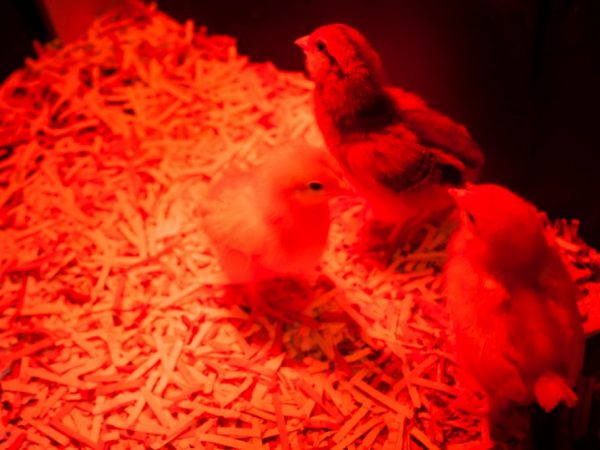

Thanks to the infrared heater, birds' appetite improves, they grow rapidly and the body's resistance to infections increases
An infrared heater for a chicken coop is considered the best option today. It consumes a minimum of energy. To heat a 10 sq. m., an IR heater with a power of 500 watts is enough. The equipment is mounted anywhere, even under the ceiling, which saves space in the room. The equipment is safe.
Bake
Heating a chicken coop in a harsh winter with stove heating has a number of advantages. The stove can be folded by hand. In this case, you only need brick, which is a cheaper material. Firewood, peat or coal are placed in the stove, and when they burn, heat is generated. The price of firewood, peat and coal varies from region to region. To understand how profitable stove heating in a particular region will be, compare the price of electricity and fuel for heating the premises during the season.
disadvantages
If the chicken coop is small, then the stove will take up a lot of space in the room, which is a disadvantage.
It will take a certain amount of time to build the furnace. In addition to her, you will have to equip a chimney. To make the structure fireproof, use refractory bricks. The structure heats up during operation, which is why it is protected from chickens. In order for the equipment to work constantly, you have to manually add fuel, which is also a disadvantage.
Lamps
Halogen or ceramic infrared (IR) lamps are often used to heat a chicken coop. The main advantage is that they emit heat and light. They are also energy-saving sources of light and heat, which makes it possible to reduce the cost of keeping birds. Small in size, the IR lamp heats large areas. For heating 10 sq. m. one lamp with a power of 250 watts is enough. Moreover, any heater of this power is larger than a red lamp. An alternative is conventional incandescent bulbs. However, they consume a lot of electricity. Also, between yellow and red to illuminate the house, it is better to choose red.
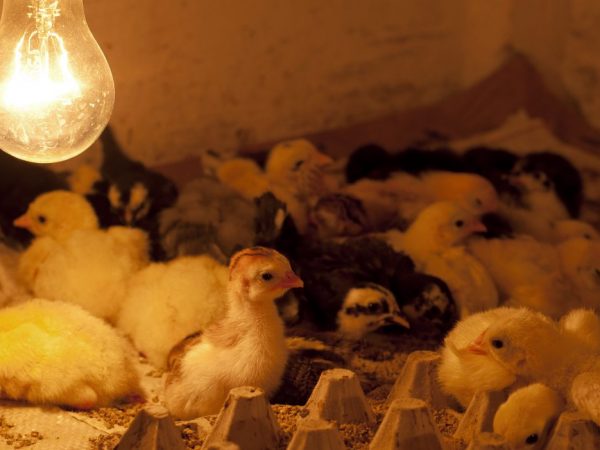

Keeping the temperature at the optimum in winter will keep chickens in good health.
A chicken coop heating lamp heats specific items, so they are energy efficient. Even during their work, the litter dries quickly, it is changed a little less often. Also, oxygen is not burned. The last advantage is the ease of lamp installation and replacement.
The only disadvantages are high pricing policy. However, they consume less electricity.
The best option is a halogen mirror IR emitter lamp, which is more suitable for heating rooms. In mirror lamps, their inner surface is covered with a special layer, which increases the efficiency of their work several times.
Less often they use a convector. Their heat radiation, in comparison with other electrical appliances, is minimal. It is costly to heat the room with it. If the choice fell on a convector, then it is better to choose models that are protected from dust and moisture.
Warming the room
To ensure the conservation of heat inside the hen house, it is necessary to insulate all surfaces of the room: floor, ceiling and walls. If the old insulation has deteriorated, rotted, it must be completely removed.
A budget option for insulation material is foam or mineral wool. With their help, the surface of the walls and ceiling is sheathed. The joints between the walls, floor and ceiling are caulked.
The natural insulation of the floor inside the hen house is a bedding made of straw, sawdust or other material. At the time of pouring the floor with concrete or cement, it is recommended to lay a layer of expanded clay - this will significantly insulate the surface.
To prevent chickens from freezing their paws in winter, the layer of natural litter is increased to 20 centimeters. Over time, the floor becomes dirty with chicken droppings, it must be cleaned in a timely manner by adding fresh litter. The ideal material for the litter is sphagnum, which additionally disinfects the surface due to its natural properties.
Ceiling
The ceiling is the main place in the room where heat goes away according to the laws of physics. Mineral wool is often used to insulate the roof in a chicken coop. To prevent it from being affected by moisture, waterproofing is laid. The hemming is usually made of wood. All cracks are covered with polyurethane foam.
Choosing equipment for a chicken coop
It is not always possible to install the equipment for heating chickens that you want. Before going to the store, the condition of the chicken coop is assessed.
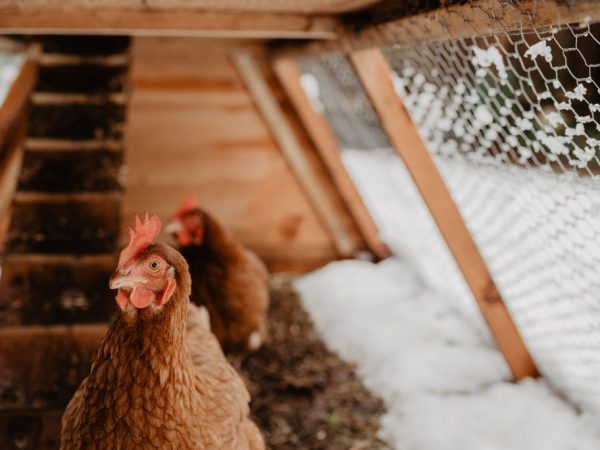

Before choosing and installing equipment for heating chickens, it is necessary to clean, disinfect and insulate the chicken coop
If the shed is well insulated and small in size, a heating lamp or low power heater will suffice. There must be a socket in the house.
If the room is large, it is better to use gas structures. An IR lamp for chicks is also suitable.
Electric heaters, even with the lowest energy consumption rates, are unprofitable to install. If the room is small, the only way out is installed under the ceiling.
The small poultry house is also heated using conventional hot water heating. It's easy to install it at home. However, such an autonomous system is expensive. But it quickly pays off during operation. It is also safe for birds and animals in the barn. Metal pipes are not heated to such an extent that birds could get burned by touching them. Moreover, such heating does not take up much space. When installing a water system, it is better to equip it with a thermostat, which will allow you to maintain the desired temperature regime in the poultry house. This option is also good if electricity is often cut off in the region.
Outcome
Infrared heaters are a godsend for poultry farmers. Their use will allow you to create comfortable conditions for your bird and yourself without special capital investments. It will be convenient for you to clean the chicken coop and feed the chickens. And they, in turn, will simply be ashamed not to thank you with their egg products.
Similar articles:
- The occurrence of limb problems in chickens
- Why do chickens stop laying in winter?
- What gives the chicken yolk color?
Heating brooder
Chickens are hatched even in winter. Not all chicken coop warmers are good for heating a brooder that holds chicks for the first time after birth. If the brooder is made at home, you will have to think about how to warm the newborn chicks.
Most often, an infrared lamp installed under the ceiling is used to heat the chicken coop. For a small area, an ordinary light bulb is also suitable, which is used to illuminate the house. With this heating method, make sure that there is no overheating.
Do not install underfloor heating system. Chicken fluff is highly likely to catch fire. Ceiling options are the safest.
Is it possible to do without an electrician
Gas and stove heating systems, traditional for our region, are an alternative to electric heaters. Each of them has its own advantages, disadvantages and conditions for rational use, however, in any case, such space heating will help to cope with any sharp drops in temperature.
Using a potbelly stove
An ordinary heating stove is the easiest way to heat a chicken coop, regardless of the climatic features of the region. This heating system consists of a metal combustion chamber (boiler) and a chimney. In the process of fuel combustion, heat is released, which heats the surrounding air through the walls of the stove.
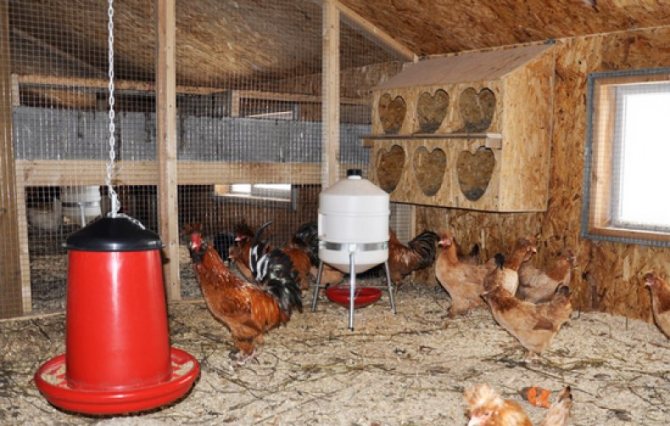

This heating system is quite practical. It does not require additional costs for maintenance, and absolutely any non-toxic material can become fuel for it. However, it is not so easy to build heating with a potbelly stove. In addition to the boiler and the ventilation pipe, the system requires strict adherence to all fire safety standards, since the potbelly stove provides for heating with an almost open flame.
Advantages of a potbelly stove:
- cheapness;
- low fuel costs;
- practicality and ease of care;
- ease of installation of the heating system.
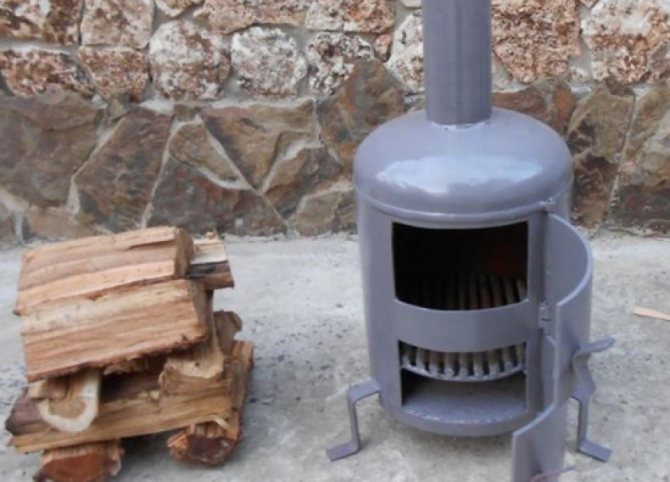

Disadvantages of a potbelly stove:
- low fire safety;
- fuel must be tossed up on your own;
- emits an unpleasant odor during operation.
Heating the chicken coop with gas
Gas heating is the most effective way to create the required temperature in the chicken coop. Gas heating systems can be of two types: water and convection. The water one is a chain of a boiler, heating elements and a combustible gas evacuation system. During the combustion process, heat is generated, which is used to heat the water.
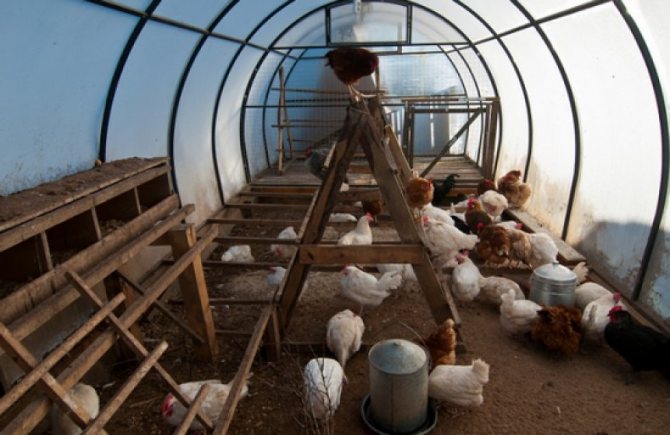

Circulating through the system, the water gives off its heat to the batteries, which directly heat the room. Convection heating is a system of spot heating elements - convectors. They function as electric convectors, but the heating element is heated by gas combustion in the sealed chamber of the device.
Advantages of gas heating systems:
- fast warming up of the room;
- energy efficiency;
- high fire safety;
- lack of unpleasant odor in the process of fuel combustion.
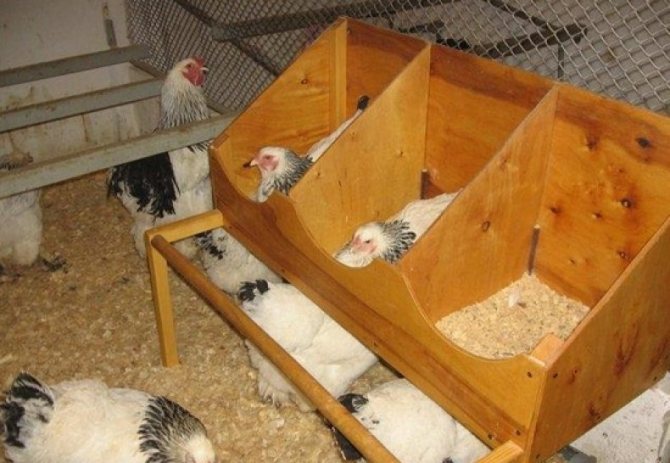

Disadvantages of gas heating systems:
- high cost of equipment;
- the need for constant monitoring of the health of the gas supply system;
- high fuel cost.
Heating a hen house is one of the most important processes in the care and breeding of poultry. Optimal climatic features for chickens throughout the year are the key to their good health and high egg production. This process must be approached as carefully as possible, since this directly affects the farm value of each individual on the farm.Therefore, the choice of the optimal heating system should take place not only on the basis of personal preferences, but also according to the efficiency and expediency of the funds spent on it.
What is better to choose
It is difficult to advise which device is better to choose for heating a chicken coop. Each host has their own preferences. Judging by the popularity, Philips' products are in the first place. The company produces red IR lamps with a tempered glass bulb and regular transparent models. The first option is the most in demand. Such lamps have a long service life, and allow you to adjust the luminous flux.
Nowadays, IR mirror lamps of domestic manufacturers have appeared on the market. They are produced with a transparent as well as a red flask. In terms of quality, they are not inferior to imported counterparts, and can last up to 5 thousand hours.


As for infrared heaters, any ceiling model with a thermostat is suitable for a chicken coop. Don't buy expensive imported models. The domestic device BiLux B800 of the AIR series has proven itself quite well. The power of the 700 W heater is enough to maintain the optimum temperature in a chicken coop with an area of up to 14 m 2.


Choosing an IR heater for a chicken coop, you need to correctly calculate its power. Usually about twenty layers are kept at home. For such a number of birds, they build a shed with a size of 4x4 m.If the chicken coop is initially well insulated, then even a 330 W heater is enough to maintain the optimal temperature.
In the video, testing an IR heater:
Features and fundamental principles of the IR lamp
To use this device correctly and achieve the desired result, you need to know how IR lamps work. They are not much different from conventional tungsten filament bulbs.
But there are features that make the lamps well suited for heating:
- The flasks additionally contain a gaseous mixture (for example, nitrogen).
- Inside, the surface of the lamps is mirrored and plays the role of a reflector.
- A special coating allows you to focus the heat on the desired area.
- As a result, energy is saved (up to 45%).
Thanks to efficient heating and economy, infrared lamps are useful in large and private households. In contrast, red lamps are used primarily for lighting, while ultraviolet lamps are used for disinfection. These two types of lamps are not suitable for heating.
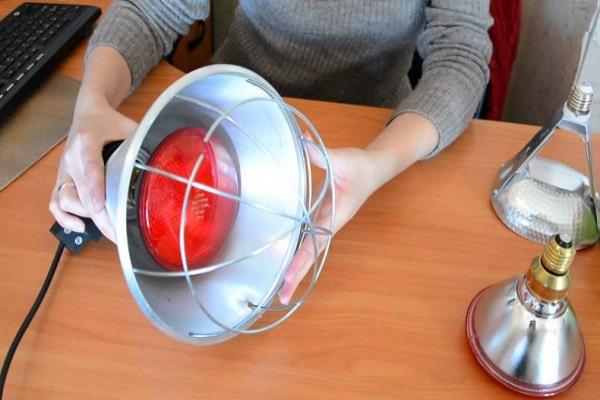

For heating
Infrared lamps do not heat the air itself, but directly the objects at which they are directed. Therefore, they warm up better, which is especially important in winter. Also, this feature allows the heaters to be placed directly under the ceiling.
When heating with other devices, the air is exposed, which then rises, and to keep the temperature, the equipment must be placed as low as possible. But in chicken coops, this is difficult to do, and besides, birds can suffer if they get to the hot elements.
For lighting
Infrared lamps are not suitable for lighting, as their radiation is rather weak and decreases even more when the device is placed under the ceiling. Chickens are daytime birds. With a lack of light, they reduce activity, eat little, and the growth rate decreases. Accordingly, egg production also suffers.
